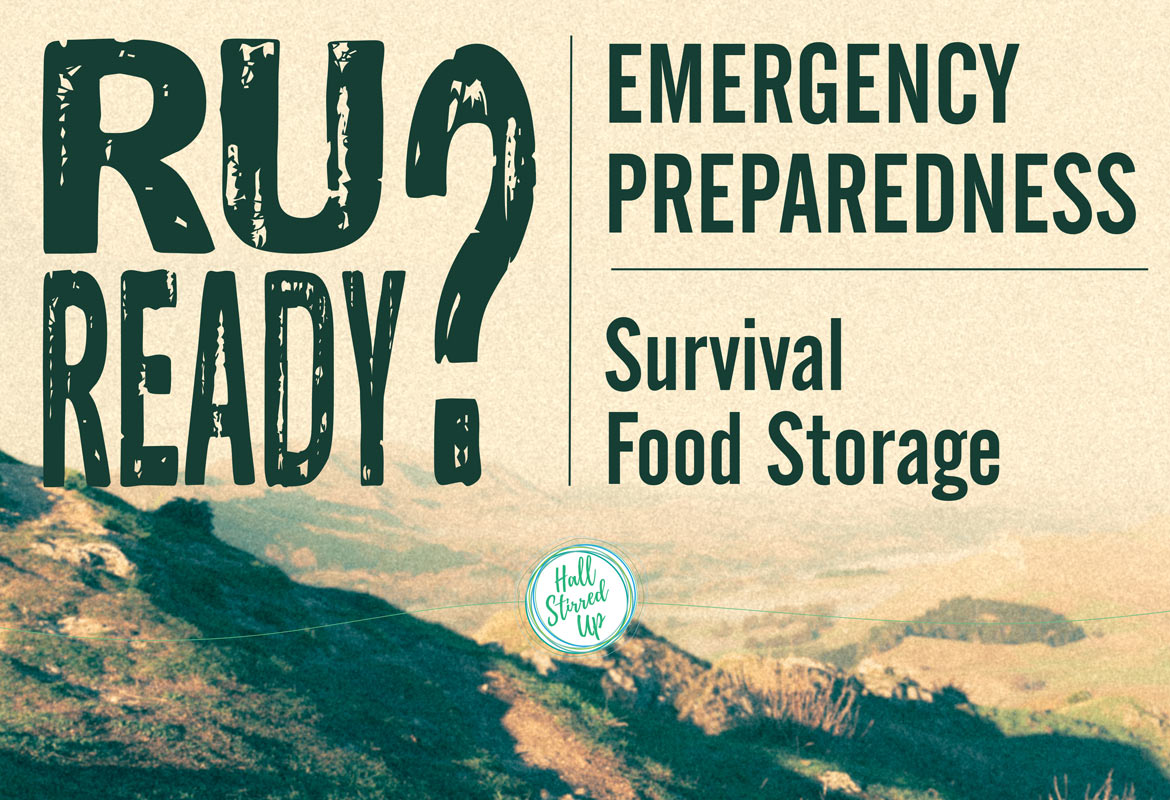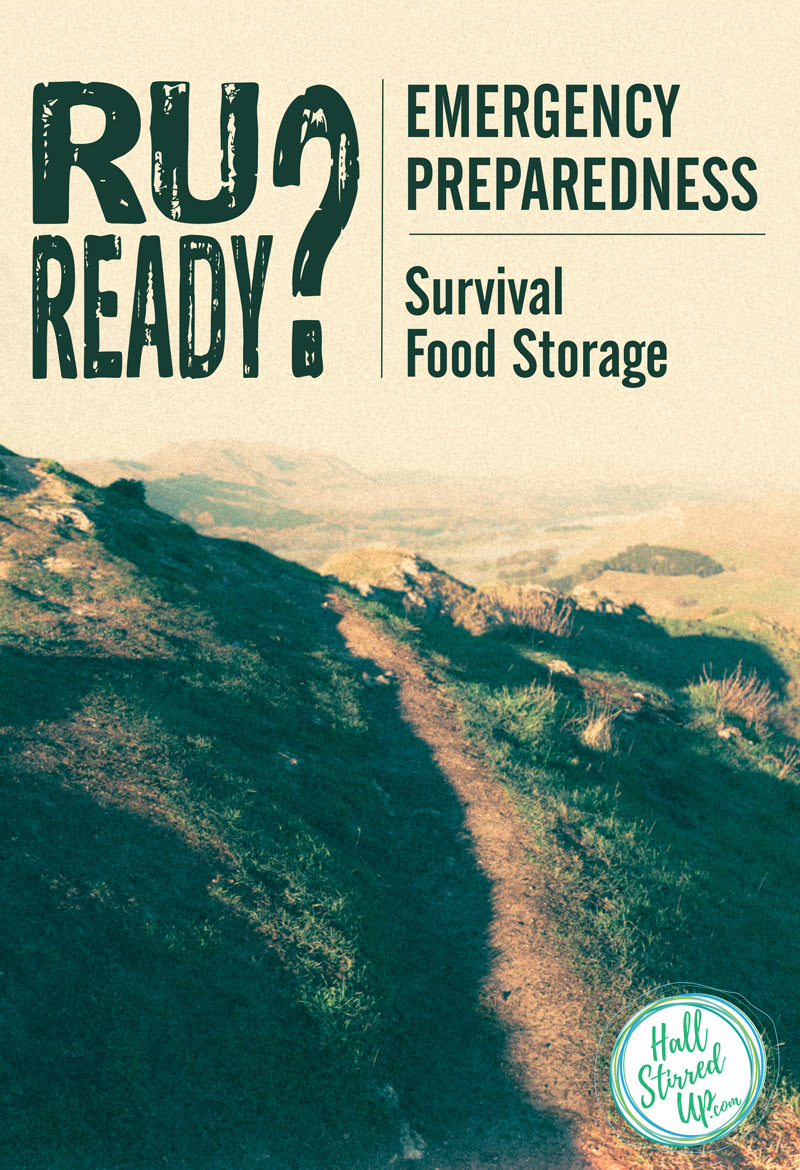
RU Ready? Disaster Planning – Survival Food Storage
RU Ready? Emergency Preparedness – What food storage will you need during a disaster?
If you’ve been following my Emergency Preparedness posts, you’ll know natural disaster is the topic. Just when things are bad, it seems to have gotten worse. Between hurricanes, earthquakes and the wildfires in California, it seems to be the season of disasters. Below are links where you can make a difference. Please contribute what you can. Every little bit will help.
The Red Cross
The Hispanic Federation (for Puerto Rico)
Las Vegas Victim’s Fund
Mexico Earthquake Victims
Salvation Army (for California wildfire victims)
Because of what’s been happening, our family has decided to make preparedness a priority. It’s so easy to be complacent, but the recent run of disasters have knocked me out of that complacency. It’s past time to be ready.
In part one of my series, I talked about what kind of disaster you may face based on your local region, and the importance of creating a family plan. Part two of my series covers 5 must-have supplies you need to include in your Emergency Preparedness plan.

This week, we’ll discuss the importance of food storage, and what are some good items to have on hand, just in case. Whether you’re sheltering in place, staying in a shelter, or even dealing with the possibility of being stuck out on the road, having food and water is your top priority in any disaster situation. You can go without power and a lot of creature comforts, but you can’t go without food and water.
Before purchasing supplies, decide how long you want to prepare for. At the very minimum, having a week’s worth of food and water on hand will be a good idea during a natural disaster. Keep in mind that you not only have to ride out the incident, but that it may also take extra time before help and supplies can make it to you. Asking some simple questions will help you determine the supplies that will provide the most benefit.
How Much Water Should You Have?
Start with your water supply. I’ve mentioned this before, but clean water is your top priority. You can make it much longer without food than without water. If you’re lucky, you may still have running water but don’t depend on your tap water as the only source of drinking water. In the event of an emergency, it could become contaminated. Buy water bottles or fill up soda bottles, etc., to ensure you have enough clean drinking water for a few days. Fema.gov recommends having one gallon of water per person per day.
What Food Do You and Your Family Normally Eat?
Emergency food storage doesn’t have to be complicated or expensive. In fact, it can, and probably should be, items you and your family already eat. A 100 lb. bag of flour may seem like a great idea, but if you don’t have any of the other necessary ingredients to make something with it, or any way to cook, it won’t do you much good.
Start with a list of things that you know your family will eat and things you’ll use up even when you don’t need them during a disaster. From there, start to round it out with things that will keep you full and healthy and pick those up as needed and budget allows. For example, you may eat canned fruit, vegetables or chicken noodle soup regularly, but aren’t a big fan of tuna. Keep a supply of the usually eaten canned goods in your pantry at all times (rotating through them as needed), and add a few cans of tuna to have on hand.
Stock Up on Non-Perishable Food
Next think about non-perishable food that your family will eat. Choose food that you can eat as-is. Crackers and peanut butter are a good choice, as are canned beans and soups. Canned meats such as tuna or chicken make a great source of protein. Don’t forget about things like nuts, granola and protein bars or beef jerky that you can eat right from the package. If you have a camping stove or a grill outside, heating and cooking some foods may be an option. Instant oatmeal, coffee, hot chocolate mix, soups, and even instant rice are great options if you have the ability to heat water when the power goes out.
Now You Can Add Some Extras
Your body needs quality nutrition, especially in times of stress, but stocking up on a few favorite treats will make getting through tough disaster days a little more bearable. Think of including packaged dry goods such as pretzels and cookies, or chocolate chips that can be added to other items or be eaten with nuts for a treat.
Make it Waterproof
There are lots of food packages that would be ruined by water, so you might want to think about putting storage items that aren’t in watertight packages into plastic storage bins or impermeable plastic bags. Flooding can turn good food storage into a soggy mess and leave you with unusable goods. Putting food in a watertight plastic bucket or plastic bags will help to keep food intact in the case of water damage.
Get the Family Involved
Talk to your family about your survival food supply and get their input into what you should stock and keep on hand. It will give them a sense of control and responsibility and helps to ensure that everyone is happy with the meals available in the event of an emergency.
Let’s Be Ready
Not everything is within our control, but with organization we can do our best to be prepared. With some effort and planning, we can be stocked with food and water in the event of an emergency.
In part of 4 of my series we’ll talk about the essential emergencies supplies you’ll want to include in your preparedness plans.
Related Articles
Part one of my Emergency Preparedness series talks about determining what you need to be prepared for and creating a family plan. Read more here.
Part two of my series covers 5 must-have supplies you need to include in your Emergency Preparedness plan.
While you’re here, sign up to receive updates and direct links to my posts and newest free printables! Subscribers receive direct links to my free printables plus exclusive freebies and digital desktop images of each month’s printable. Don’t miss out!
Related articles across the web





Leave a Reply